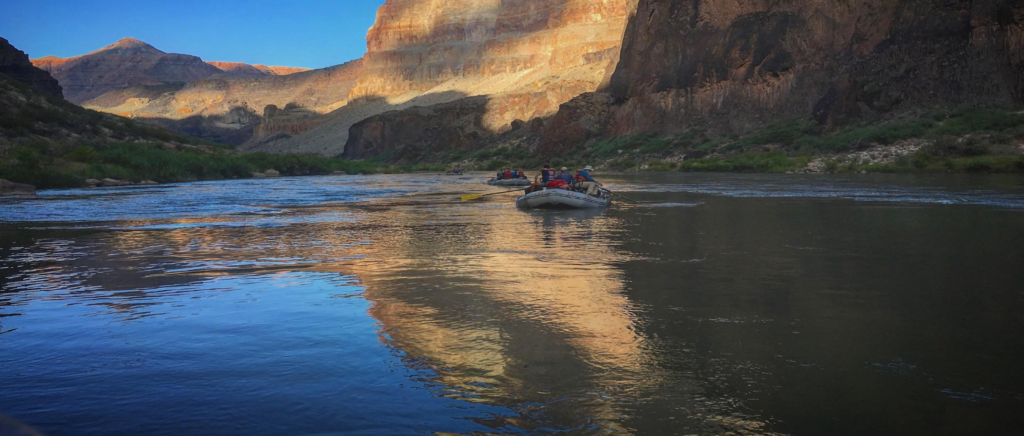
For Immediate Release, April 17, 2023
Contact: Kelly Burke, (928) 606-7870, kelly@wildarizona.org
Ben Reeder, (801) 860-1070, benreeder33@gmail.com
Jim Strogen, (480) 242-2569 jimstrog@gmail.com
(photos courtesy GCRG Adopt-A-Beach Program)
Recreation and Conservation Stakeholders applaud Reclamation Decision to Release First Springtime High Flow since 2008, to Benefit the Colorado River Ecosystem in Grand Canyon
FLAGSTAFF, Arizona— Wild Arizona’s Grand Canyon Wildlands Council, Grand Canyon River Guides, and Trout Unlimited proclaimed full support today, of the Bureau of Reclamation’s determination to proceed with a Spring High Flow Experiment in late April. This will be the first springtime high flow release from Glen Canyon Dam since 2008 to restore sandbars and shoreline habitats along the Colorado River in Grand Canyon.
For the past 60 years, Glen Canyon Dam has captured and held Colorado River sand in Lake Powell upstream from Grand Canyon. Fine sediments for sandbars and shoreline habitats in upper Grand Canyon are now primarily carried into the Colorado mainstem by the Paria River, below Lees Ferry where boats launch for river trips downstream and fishing trips upstream in Glen Canyon.
Occasional high flow events (HFEs) are needed to keep these iconic beaches and river habitats from dwindling away. In keeping with the 1992 Grand Canyon Protection Act and to rectify these erosion losses, the Secretary of the Interior directs the Bureau of Reclamation to release occasional planned flood flows when sufficient Paria River sediments accumulate in the mainstream channel.
However, as Wayne Pullan, the Secretary of the Interior’s Adaptive Management Program Designee stated in the decision memo authorizing this month’s HFE that, under the 2016 dam management plan, ‘HFEs were predicted to be conducted frequently (~3 out of every 4 years) and it has been four years since the most recent HFE was triggered and implemented (fall 2018), and no spring HFEs have yet to be triggered.’
“Under periods of generally higher dam releases, Paria River sand is quickly flushed downstream, necessitating November HFEs to move sand provided during the summer, up higher onto the beaches,” said Dr. Larry Stevens, senior ecologist for Wild Arizona’s Grand Canyon Wildlands Council, “but with ongoing drought and low release conditions conserving the sand, we have this opportunity to conduct an HFE in springtime, the natural time for such flows and when they are likely to be most appropriate for native fish and wildlife species. In addition, springtime HFEs should provide improved sandbars for summertime river running.”
Kelly Burke, the Council’s director, stated: “this is an important experiment, one that will inform future Colorado River and dam management by providing insight into seasonally-appropriate high flow design, habitat restoration, and aquatic foodbase and native fish spawning responses.”
Due to the wet 2022-2023 winter, this planned HFE will be a preemptive effort to rebuild beaches and thus conserve sand supplies during anticipated erosive high flows through this upcoming summer.
The camping beaches and sandbars in Grand Canyon that are used by over 25,000 river runners each year have not been rebuilt since the last High Flow Experiment (HFE) in fall of 2018.
“The last two summers we have witnessed the unraveling of sandbars in Grand Canyon as an effect of violent monsoon patterns,” observed Ben Reeder, professional river guide and GCDAMP Technical Workgroup representative for GCRG. “The result has been the worst beach conditions downriver in 20 years. Not only does this detract from the quality of a river trip, it also signifies a declining ecosystem. This action shows that adaptive management is possible – even under the pressures of drought management, water, and power obligations. The balance found here is encouraging!”
According to Lynn Hamilton, GCRG’s Executive Director, “the decision to implement a naturally timed spring HFE represents a huge step forward in our learning as well as our ability to protect and improve downstream resources in keeping with the mandates of the Grand Canyon Protection Act of 1992.”
Despite the expected reprieve brought by substantial snowfalls this year and the resultant filling of upstream reservoirs, dire conditions still face the Colorado River below Lake Powell. The lake was recently at 22% capacity and the dam was close to being unable to generate power. The water coming into the river from the lake had warmed to the point of threatening the rainbow trout fishery below the dam that depends on cold water.
These higher release temperatures also provide suitable habitat and rearing conditions for warmwater and cool water predators that will endanger the native fish downstream. The lower lake levels put these warm and cool water fish in Lake Powell perilously close to the penstocks where their release through the dam into the river below further endangers the trout fishery and the protected native fish downstream.
“We have long sought the inclusion of more spring HFEs in the LTEMP process for recharging sediment to the river,” said Jim Strogen, Adaptive Management Workgroup representative for Trout Unlimited. “The timing of spring high flows is much more in keeping with the natural occurrence of flows historically in the Colorado River, and we believe will provide greater biological benefits than fall HFEs. We value the replenishment of the beaches that have been in need of recharging due to the impact of flash floods and the lack of HFEs for quite some time. While the predicted water conditions, due to favorable snowmelt, will help us this year, we must continue to find ways to conserve water and be prepared to implement strategies to protect the river and its inhabitants when these harsher conditions return.”
###
Wild Arizona’s Grand Canyon Wildlands Council is dedicated to protecting and restoring the native species and natural ecosystems—the intricate web of life—along the Colorado River through Glen and Grand Canyons.








